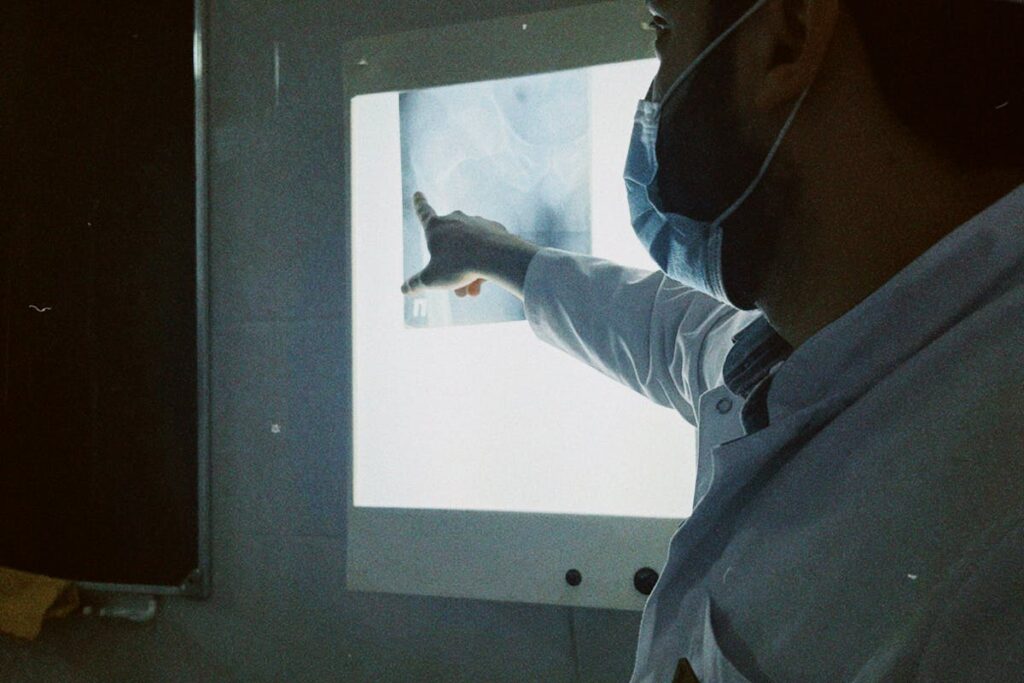Spinal cord stimulation (SCS) represents a compelling frontier in the management of chronic pain, utilizing low-voltage electrical currents to disrupt pain signals before they reach the brain. As an innovative, adjustable, and minimally invasive technique, SCS offers a new lease on life to those who have found little relief in conventional treatments. But what is the science behind this technique, and how exactly does it work? Furthermore, who are the ideal candidates, and what potential risks should patients and providers be aware of? As we explore these questions, we will uncover a deeper understanding of spinal cord stimulation.
Understanding Spinal Cord Stimulation
While it may seem complex, spinal cord stimulation is an advanced medical technique used to alleviate chronic pain. This procedure applies low-level electrical currents directly to the patient’s spinal cord. The stimulation disrupts nerve impulses, particularly those transmitting pain signals to the brain, thereby providing significant pain management benefits.
The device used, known as a spinal cord stimulator, is typically implanted under the skin through a minimally invasive surgical procedure. It generates an electrical current which is transmitted to the spinal cord via implanted leads. This process successfully alters the perception of pain, replacing it with a more pleasant tingling sensation. As a result, spinal cord stimulation has become a crucial tool in the field of contemporary pain management.
Historical Background of Spinal Cord Stimulation
Having explored the process and benefits of spinal cord stimulation, it is pertinent to examine its origins to gain a deeper understanding of this innovative medical procedure. The historical milestones of spinal cord stimulation trace back to the 1960s, with early experiments conducted by neurosurgeon Dr. Norman Shealy. His groundbreaking work demonstrated that electrical stimulation could effectively alleviate chronic pain. Over the years, advancements in technology and a deeper understanding of neurophysiology have refined this technique. While the basic premise remains unchanged, the evolution of spinal cord stimulation has led to significant improvements in patient outcomes. This historical perspective not only testifies to the efficacy of spinal cord stimulation but also paves the way for future innovations in the field.
Components of a Spinal Cord Stimulator
In order to fully understand the function and efficacy of spinal cord stimulation, it is essential to examine the various components of a spinal cord stimulator. This device primarily comprises a generator, lead wires, and electrodes. The generator, often implantable, serves as the power source. The lead wires, connected to the generator, transmit electrical currents to the spinal cord. Electrode placement is vital as it directs these currents to specific nerve fibers. Device types vary, offering different stimulation modes and programming options. Some models feature rechargeable generators, while others are non-rechargeable. Depending on the patient’s needs and the nature of their pain, the components of spinal cord stimulators can be tailored to optimize therapeutic outcomes.
The Science Behind Spinal Cord Stimulation
To comprehend the therapeutic efficacy of Spinal Cord Stimulation (SCS), it is critical to understand its underlying science. This involves an exploration of its operational mechanism, as well as its physiological interaction with the human nervous system. Our discussion will thereby focus on these key aspects, providing a thorough understanding of the science that drives SCS.
Understanding Spinal Cord Stimulation
Spinal cord stimulation, a cutting-edge medical advancement, harnesses the power of electrical signals to alleviate chronic pain. This innovative approach to pain management implements neurostimulation techniques that target the spinal cord, interacting directly with the body’s natural electrical system.
The process involves the implantation of a small device that sends mild electrical pulses to the spinal cord. These pulses interrupt the pain signals before they can reach the brain, effectively reducing the perception of pain. It is essential to recognize that spinal cord stimulation doesn’t eliminate the source of pain; rather, it changes the way your body perceives it. This technology offers hope for patients with chronic pain conditions, providing a scientifically-grounded alternative to traditional pain management methods.
Mechanism of Action
Shifting our focus from the general understanding of spinal cord stimulation to its underlying scientific principles, we explore the mechanism of action that makes this technology effective. This process hinges on the concept of pain modulation. Simply put, spinal cord stimulation works by altering pain signals before they reach the brain. A device, implanted in the body, sends mild electrical pulses to the spinal cord. These pulses interfere with the neural pathways that transmit pain signals, effectively distorting or blocking them. This disruption doesn’t eliminate the source of pain but changes the brain’s perception of it, often resulting in significant pain reduction. Consequently, spinal cord stimulation offers a unique method of pain management by directly interacting with the body’s neural pathways.

Procedure for Implanting the Stimulator
Maneuvering through the intricate structure of the human body, a surgeon meticulously implants the spinal cord stimulator. This sophisticated surgical technique begins with patient preparation, involving preoperative assessments and anesthesia administration. Through a small incision, an epidural needle is inserted into the spinal canal. The surgeon then threads the stimulator wires (leads) through this needle. With the aid of real-time x-ray imaging (fluoroscopy), the leads are positioned in the precise spinal region corresponding to the source of pain. Subsequently, the stimulator device, typically implanted in the buttock or abdomen, is connected to the leads. The device’s settings are then programmed to optimize pain relief. This highly specialized procedure demands exceptional surgical skill, precision, and attention to detail, ensuring the stimulator effectively modulates the patient’s pain signals.
Potential Risks and Complications
While the implantation of a spinal cord stimulator is a sophisticated surgical procedure designed to alleviate chronic pain, it is not without potential risks and complications. One principal concern is the infection risk, which could potentially result in device removal. Likewise, there’s the possibility of device malfunction or hardware failure, which may necessitate further surgical interventions. Additionally, surgical complications such as nerve damage and lead migration could occur, potentially exacerbating chronic pain. The recovery process might also present challenges, including physical discomfort and psychological effects such as anxiety or depression. Consequently, while spinal cord stimulation offers a promising approach to managing chronic pain, patients should be thoroughly informed about these potential risks and complications to make an informed decision.
Benefits of Spinal Cord Stimulation
Despite the potential risks and complications, the implementation of spinal cord stimulation brings with it several notable benefits that may greatly improve the quality of life for patients with chronic pain. Primarily, the procedure offers significant pain relief by disrupting the pain signals sent to the brain. This can result in a substantial reduction of discomfort and a lessened reliance on pharmaceutical pain management. Concurrently, improved mobility is another remarkable advantage, often leading to an enhanced capability to perform daily tasks and participate in physical activities. Additionally, the treatment is reversible and adjustable, providing flexibility to tailor the therapy to the patient’s evolving needs. These benefits, coupled with the potential for fewer side effects compared to systemic treatments, make spinal cord stimulation a compelling option for chronic pain management.
Ideal Candidates for Spinal Cord Stimulation
Identifying the ideal candidates for Spinal Cord Stimulation demands an extensive understanding of chronic pain conditions, a thorough evaluation of the candidate’s health and lifestyle, and an assessment of previous treatment efficacy. Chronic pain conditions, their characteristics, and impacts on the individual’s life need to be closely examined. In addition, the patient’s overall health, lifestyle, and the effectiveness of prior treatments also play a pivotal role in determining the suitability for this therapy.
Understanding Chronic Pain Conditions
How can one define the ideal candidate for spinal cord stimulation? Primarily, these individuals suffer from chronic pain conditions that have not responded effectively to conventional pain management strategies. Chronic pain, characterized by pain persisting for more than three months, can result from various medical conditions such as failed back surgery syndrome, complex regional pain syndrome, or neuropathic pain. It is a complex and multifaceted issue that can severely impact a person’s quality of life. Spinal cord stimulation is a treatment modality that directly targets the nervous system, potentially offering significant pain relief for these patients. Consequently, those with intractable, severe chronic pain, unresponsive to other treatments, may be ideal candidates for this innovative approach.
Evaluating Health and Lifestyle
What factors come into play when evaluating the health and lifestyle of potential candidates for spinal cord stimulation? Thorough health assessments are conducted, examining medical history and current health conditions. Lifestyle adjustments are also essential considerations. For instance, patients’ readiness to modify habits affecting their health, such as diet, exercise, and stress management is evaluated. The patient’s psychological state is also assessed, as it greatly influences their response to pain and treatment. This includes examining factors like depression, anxiety, or unrealistic expectations about the procedure’s outcomes. It is important to highlight that ideal candidates shouldn’t have active untreated drug addiction issues. As a result, assessment of health and lifestyle plays a key role in determining the suitability of spinal cord stimulation for potential candidates.
Assessing Prior Treatment Efficacy
Why is the evaluation of prior treatment efficacy vital in selecting ideal candidates for spinal cord stimulation? Prior treatment history provides valuable insights into a patient’s responsiveness to different medical interventions. This effectiveness evaluation is fundamental as it helps health professionals predict the potential success of spinal cord stimulation. An ideal candidate for this procedure typically has a treatment history reflecting minimal relief or unsatisfactory side effects from conventional therapies. Evaluating prior treatment efficacy can, consequently, guide physicians in determining the appropriateness of spinal cord stimulation for each patient. This involves a thorough review of past treatments, their duration, dosage, and response, along with any adverse reactions. Essentially, such evaluations contribute greatly to personalized, effective pain management strategies.
Frequently Asked Questions
What Is the Recovery Time After a Spinal Cord Stimulation Procedure?
The recovery time post spinal cord stimulation procedure varies, typically between 2-6 weeks. This period involves careful post-operative care, closely monitored by medical professionals to guarantee recovery milestones are successfully met and complications are avoided.
Can I Perform Daily Activities With a Spinal Cord Stimulator Implanted?
Yes, daily activities, including exercise, can generally be performed with a spinal cord stimulator implanted. However, certain activity limitations may apply depending on the individual’s health condition and the specific device used.
Does Insurance Cover the Cost of Spinal Cord Stimulation Treatment?
Coverage options for spinal cord stimulation treatment vary widely. Most insurance policies provide some level of coverage, but specifics depend on individual plans and policy details. Consultation with your insurance provider is highly recommended.
What Alternatives Exist if Spinal Cord Stimulation Is Not Effective?
If spinal cord stimulation proves ineffective, alternative treatment options exist. These may include medication management for pain relief, or physical therapy to improve strength and flexibility, potentially minimizing discomfort and enhancing overall functionality.
Can the Spinal Cord Stimulator Be Removed if Necessary?
Yes, a spinal cord stimulator can be removed if necessary. The removal process is typically a straightforward surgical procedure. Patient experiences vary, but most report minimal discomfort during the stimulator’s extraction.
